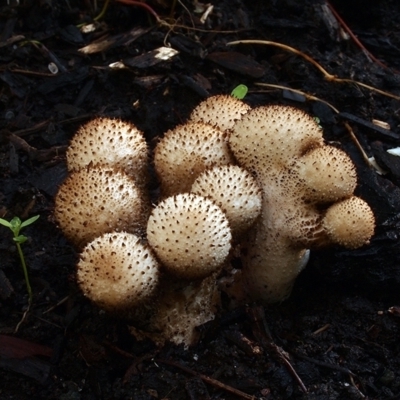Lycoperdon perlatum (Gem Studded Puffball)
,<p class="MsoNormal" style="margin-bottom: .0001pt; line-height: normal;">The fruitbody is a puffball and consists of an enlarged, spore-bearing section atop a narrower, sterile base. The base may be relatively short (thereby giving the puffball a pear-like shape) or longer (to produce a pestle-like shape). These puffballs are commonly up to about 6 cm tall (and 2-4 cm wide in the upper area), but larger examples occur. The young puffball is white and solid. The mature puffball is brown with the upper area containing powdery spores in a cottonwool-like mass of filaments and the lower area having a spongy feel (because, internally, it has numerous small cavities, like foam packaging).</p>
<p class="MsoNormal" style="margin-bottom: .0001pt; line-height: normal;"> </p>
<p class="MsoNormal" style="margin-bottom: .0001pt; line-height: normal;">The surface (in particular of the upper section) of the immature puffball bears stout, conical spines (up to a millimetre or so in length), each surrounded by numerous very low warts. With age the spines are likely to fall off fairly readily whereas the warts persist for much longer. If only a fairly small percentage of spines have fallen off, the surface will have a pock-marked look. If the majority of have fallen off, to leave virtually only the low warts, then you will see a reticulate pattern on the surface.</p>
<p class="MsoNormal" style="margin-bottom: .0001pt; line-height: normal;"> </p>
<p class="MsoNormal" style="margin-bottom: .0001pt; line-height: normal;">At maturity there is a well-defined apical opening, through which the spores puff out.</p>
<p class="MsoNormal" style="margin-bottom: .0001pt; line-height: normal;"> </p>
<p class="MsoNormal" style="margin-bottom: .0001pt; line-height: normal;">These puffballs are found on soil in a variety of habitats, often in large and densely packed groups.</p>
<p class="MsoNormal" style="margin-bottom: .0001pt; line-height: normal;"> </p>
<p class="MsoNormal" style="margin-bottom: .0001pt; line-height: normal;"><strong style="mso-bidi-font-weight: normal;">Look-alikes</strong></p>
<p class="MsoNormal" style="margin-bottom: .0001pt; line-height: normal;"><em style="mso-bidi-font-style: normal;">Lycoperdon excipuliforme</em> has a similar shape but lacks the pockmarked/reticulate patterning and the spines are grouped (see <a href="../47095">https://canberra.naturemapr.org/species/47095</a> for more information).</p>
<p class="MsoNormal" style="margin-bottom: .0001pt; line-height: normal;"> </p>
Lycoperdon perlatum is listed in the following regions:
Canberra & Southern Tablelands | Tasmania
Species information
- Lycoperdon perlatum Scientific name
- Gem Studded Puffball Common name
- Not Sensitive
- Local native
- Non-invasive or negligible
- Up to 638.2m Recorded at altitude
- Machine learning
Location information
-
Maps
ANBG










